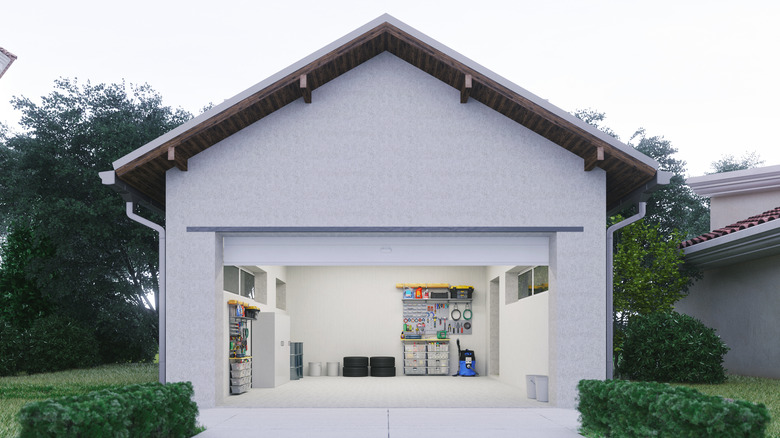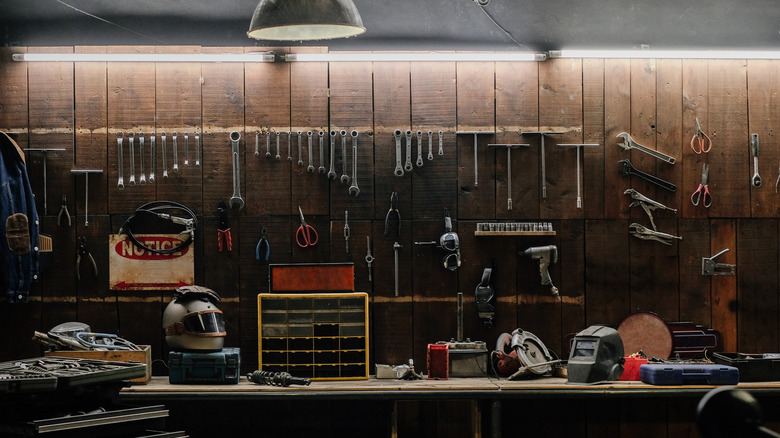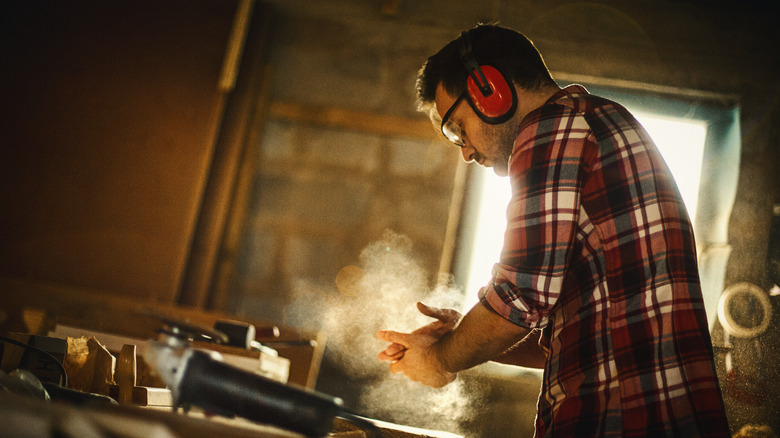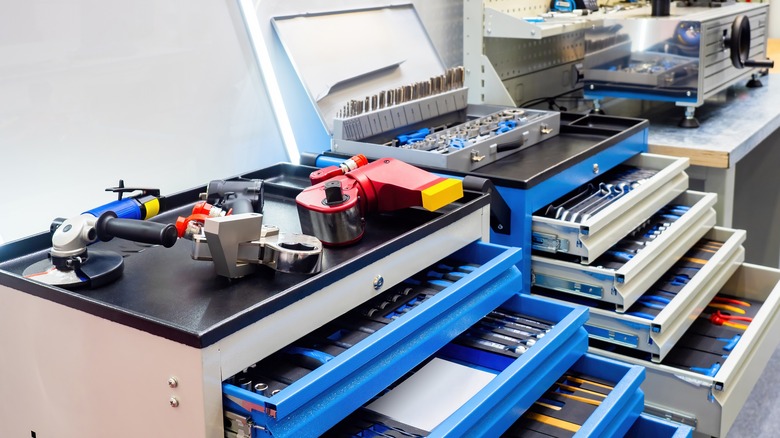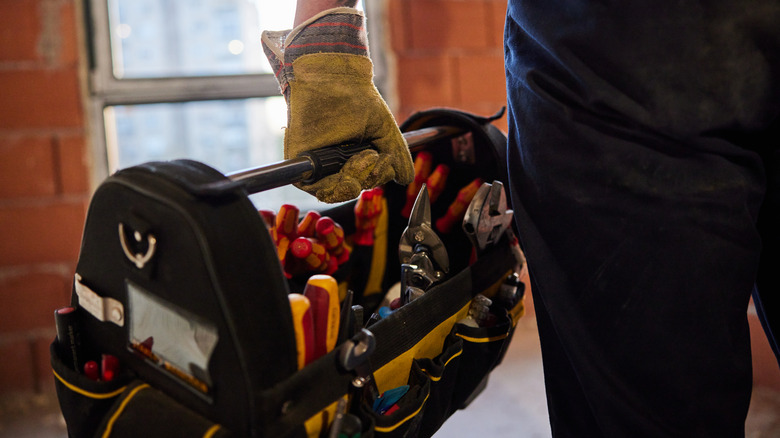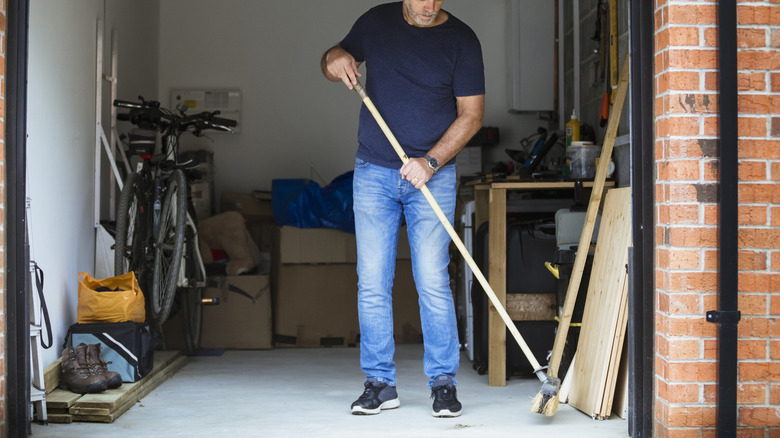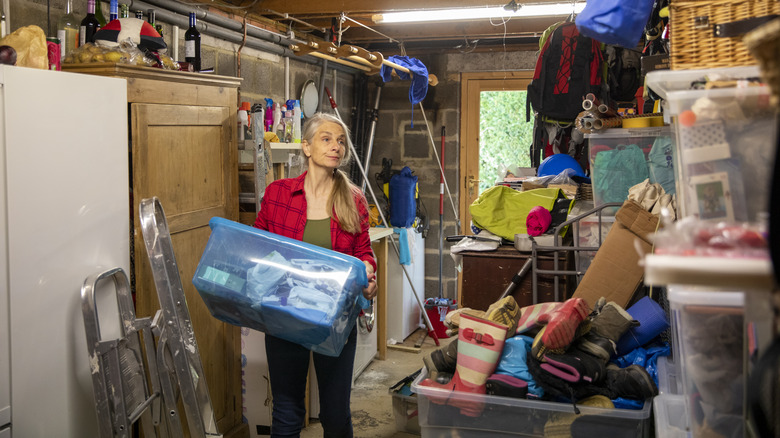5 Helpful Tips For Organizing The Tools In Your Garage
There are endless benefits to having an organized home. Aside from helping you monitor your supplies and find things quickly when needed, several studies show how clutter and mental health are connected. In 2009, a Personality and Social Psychology Bulletin study shared that women who described their living spaces as cluttered or full of unfinished projects had a higher likelihood of feeling fatigued and depressed compared to women who believed that their homes were restful and restorative.
Two years later, the National Library of Medicine published another study claiming that a cluttered visual environment leads to multiple objects fighting for your attention, which leads to reduced focus and productivity. With this, it's unsurprising that keeping an organized home is a challenge that many of us believe is worth it. And one area of our homes that tends to get cluttered the most? The garage.
In 2022, a Craftsman study revealed that 62% of U.S. adults feel their garage is the most cluttered space in their home, with 36% of respondents sharing that they can't even park their vehicles in it (via PR Newswire). In the study, Craftsman also shares that more than half of its respondents claim to use their garage for other activities, such as an at-home workshop for DIY projects.
If you're one of those people whose garage is a lively place where things get done, you may wonder how to control your seemingly endless list of tools. Here are some tips you can try.
Conduct an inventory
When organizing any area of your home, one of the first things you should always do is take inventory of what you already own. While this process can appear time-consuming and physically exhausting, it is an important step that can help inform the rest of your garage organization experience.
By doing an inventory, you can spot what tools you already own, any unnecessary duplicates, and if you lack any toolbox essentials that would help improve your workflow. Aside from this, you can also spot which tools are in need of repair or replacement. Additionally, it's also a good opportunity to check which tools are still under warranty, which can come in handy if you ever experience any issues with your tools in the future. Throughout the inventory process, you can either do it using a piece of paper, take pictures and save them in an album on your mobile phone, or download a home inventory management app.
When grouping tools, you can temporarily use small boxes for loose items like screws or nails or large boxes for hand-held tools. If you already feel that you'll need to do complex renovation or repairs on your garage, having your tools already in boxes can definitely make the packing-up and unloading process less painful overall. While you're at it, you should also have pen, paper, and tape, which you can use for temporary labels, especially if you'll be using boxes that are not transparent.
Design dedicated workspaces
Before you start buying organizers, racks, or stacking boxes, you must first take the time to plan things out. Not only can this help you save money by avoiding unnecessary purchases, but it can also give you a more practical view of how you can effectively utilize your existing space.
First, you need to take into consideration the size of your garage and how much space you want to allocate for your car, storage, and other activities. Second, you need to create an outline of your existing garage, including doors, existing lighting fixtures, charging plugs, or other items that are difficult to remove, like bolted furniture.
Third, you can proceed to draft out which areas of the garage are feasible to dedicate for certain things or activities. For example, if you need a table to do woodworking, you'll need to check if there is enough space, as well as the proximity to plugs.
Fourth, you can either purchase, build, or use existing storage solutions, such as shelves, work benches, cabinets, or racks. Once you have a general layout for your preferred workspaces, there are plenty of lifehacks you can try to get more out of your garage space.
Aside from the usual space-saving solutions, you can also utilize peg boards to mount equipment on walls, magnetic strips for metal tools, or hang storage boxes from the ceiling. However, it's best to measure everything to make sure you can still comfortably fit your vehicles and move around.
Store similar items together
With an inventory, you can create visual estimates more reliably and understand the quantity and size of items you are working with. Not to mention, it helps inform what tools you need to be accessible more frequently or how to build a space that makes it easier to use. After doing your inventory process, you can proceed to store tools by similarity or function.
Depending on the type of items you're storing, you may want to use either clear or opaque containers. While transparent boxes may be good for letting you see what's on the inside, they don't protect the items inside them against the effects of sunlight. Since our garage tends to house more than just our tools, things like clothes, gadgets, or even food need to be stored appropriately to avoid damage. In general, it's best to use opaque boxes for items that have colors that may fade, get distorted, or have batteries that may be affected by heat.
In addition, opaque boxes are great for hiding more expensive items or tools, which may tempt visitors or people who pass by. For smaller items, like nails, bolts, or screws, you can use things like mason jars. In addition, it may be a good idea to get a label maker, like the Brother PT-D600, Epson LabelWorks LW-600P, or King Jim Tepra Pro SR600 Label Writer. Using this, you can print labels manually or through your mobile phone, which you can use to label storage boxes.
Organize tools by use and frequency
While you can have hundreds of tools at your disposal, most people use only a few in their daily lives. Before you embark on your reorganization journey, it's best to know which tools matter the most and if you own more than you should. Although most people can tell which tools get used more frequently based on experience, you can also opt to keep a tool log on paper or mobile phone, which can help you decide how to prioritize them in your storage.
When you organize your garage for the first time, it's okay not to have a perfect setup right away. You can adjust as you go along. However, make sure not to skimp on the most crucial car cleaning tools, which can help keep the inside of our vehicle clean, too. If you need to have things on the go, you can also get a snap-on toolbox for your everyday tools. Depending on your needs, different toolboxes will have characteristics like colors, weatherproofing, or even those with wheels.
Or, if you're a little bit of a hoarder and own almost every tool out there, you can invest in Milwaukee toolboxes that have a large capacity, which is more than enough for the average person. On the other hand, you can also opt to store less frequently used tools in more difficult-to-reach locations, such as higher shelves, overhead spaces, or hung from the ceiling.
Schedule maintenance calendars
Once your garage is back in order, you can proceed to make plans on how to keep it that way. If you live with family members or have roommates, it's best to be aligned on how to share responsibility for garage and tool maintenance. Aside from making sure the general area and walkway are free of clutter, it's good to also stay committed to taking care of individual tools and returning things to their appropriate storage areas at all times.
By taking the time to learn how to clean your power tools, you can extend their lifespan, keep them running better for longer, and avoid unnecessary injuries. When cleaning specialized tools, consulting the owner's manual can make a difference. After all, not all tools are alike, and some may require special cleaning materials for their extended care. Not to mention, cleaning your tools regularly also gives you insight into which tools may no longer be functioning correctly, such as battery management or charging issues.
Although it's always recommended to keep some basic cleaning and maintenance materials in your garage, such as buckets, steel wool, toothpicks, cleaning rags, and compressed air. If you own a lot of power tools, having stock of WD-40, different-sized screwdriver heads, and some degreasers can also go a long way.
Lastly, you can also invest in personal protection gear, such as gloves, goggles, and aprons, which can help keep you safe from sharp objects, spills, or debris during your regular tool maintenance practices.
Keep the garage chaos at bay
By organizing your garage, you not only have easier access to your tools when you need them, but you also get to repair any potential issues or replace tools before you urgently need them. Having well-kept tools significantly reduces problems in the event of a repair emergency.
In addition, keeping your garage organized is also one way to keep mice or other rodents from nesting inside your house. When left unchecked, mice can introduce parasites to your pets, trigger asthma and rhinitis for family members, and contaminate food supplies with their bodily fluids.
If you find that maintaining your garage is too much for your mental load, you can outsource some of these tasks, whether to a regular cleaner or even machines. Aside from your usual robot vacuum, there are also a growing number of emerging technologies designed to reduce the amount of chores on your plate.
For most people, keeping your tools organized and your garage clean can make a big difference in your everyday life. After all, when you're parking your car after a long day at work, it would be nice to be greeted with an organized, clean home right when you arrive.
